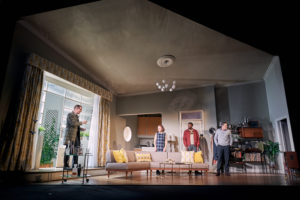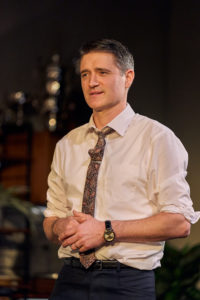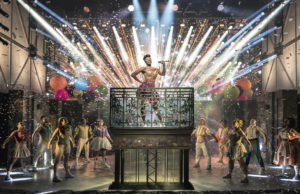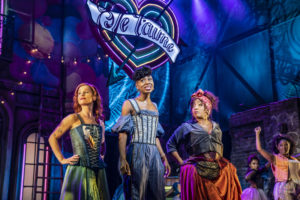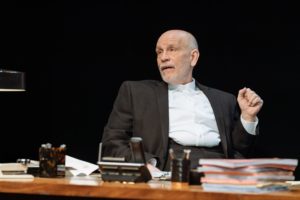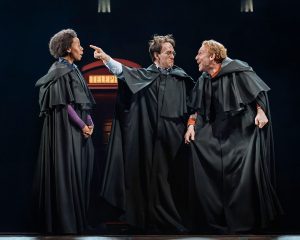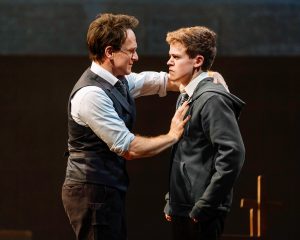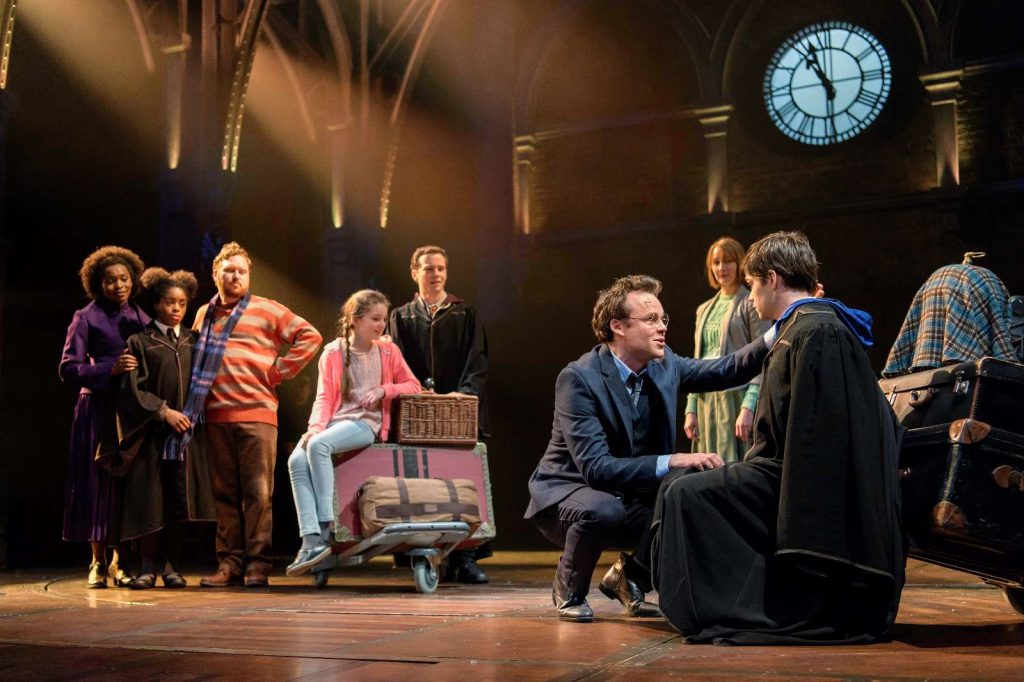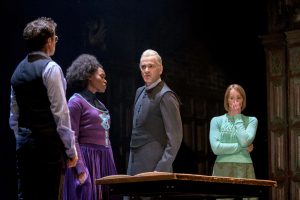James Corden’s finest moment on stage not quite captured on film
★★★★★ (National Theatre production) ★★★ (NTLive recording)
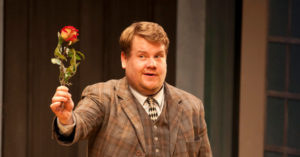
I saw One Man Two Guvnors at the National Theatre back in 2011 and would have given it five stars if I’d been posting reviews back then. It is a love letter to theatrical comedy. So, how do you tackle recording on film a play that is all about the stage?
Richard Bean’s script and Nicholas Hytner’s production are a tribute to Commedia dell’Arte and its influence on subsequent comedy such as Music Hall, pantomime and farce. It’s a deliberately theatrical show- shouty and with over large gestures. It shouldn’t work on screen and, for a few minutes at the beginning, I did fear that it was going to be everything I hate about recordings of stage shows.
Then I realised NTLive had been very clever. They made hardly any concessions to film, barring the odd close-up. There are many views of the proscenium arch and of the whole stage. The actors weren’t miked, which they often are for live recordings, so the sound is echoey. What better way to film a self consciously theatrical show than by confronting its theatricality?
One Man Two Guvnors is probably best remembered as being James Corden’s finest moment on stage and this recording is worth seeing for his performance alone but it is a production of all-round excellence. Starting with the script.
Richard Bean‘s play is an adaptation of Goldoni’s The Servant of Two Masters. This 1746 classic comedy came directly out of the Italian tradition of Commedia dell’Arte, which is pretty much the earliest form of European theatre.
The playwright has stayed faithful to Goldoni’s original story, but relocated it to 1963, recent enough to feel contemporary but long ago enough to be able to get away with sexist stereotypes and language. James Corden as Francis Henshaw, in a checked outfit, a toned down version of the Commedia dell’Arte Harlequin character’s traditional chequered costume, decides to earn some extra money by working for two bosses and then gets into all manner of confusion trying to juggle those jobs.
More than an adaptation of Goldoni, Richard Bean makes One Man Two Guvnors a tribute to Commedia dell’Arte’s influence on theatre. The standard characters and plots, so recognisable across all cultures and centuries, formed the basis of many of our comedies and comic traditions ever since. You’ll find it in everything from da Ponte’s libretti for Mozart’s operas to The Benny Hill Show.
So we get a Music Hall style production, with an emphasised proscenium arch and a skiffle band playing musical interludes between scenes. The set designed by Mark Thompson uses what appear to be traditional flats- pieces of flat wooden scenery- to add to the old fashioned feel.
We get pantomime elements- Pantomime itself being a direct descendant of – such as a slush scene where Francis serves dinner to both his guvnors while trying to keep them apart in separate rooms, and eating most of the meal himself. Doors open and shut, the two bosses appear and disappear, food and drink get mixed up and reduced as Francis tries to eat most of it, people are knocked over, all ending in a climax of flames and foam.
Talking to the audience and audience participation and the accompanying improvisation, familiar from both music hall and pantomime, are a key feature of this play and provide some of the funniest moments, whether they are really as spontaneous as they appear or not.
We get knockabout Farce: Francis falls over a chair trying to catch a nut in his mouth; Stanley, one of his guvnors, uses him as a punchbag; or, in one of the most laugh-out-loud moments, an elderly servant Alfie, played fearlessly by Tom Edden, is pushed headlong down some stairs.
Physical comedy, wordplay and first class acting

In fact, he has many of the funniest physical moments, from being hit by a cricket bat to having his pacemaker turned up so his shoots around the room like a pinball. These, for me, were the best bits of the evening and credit here goes to the associate director Cal McCrystal who was responsible for the physical comedy.
There is even a scene where two characters have their trousers down, reminding me at least of the inevitable moment in the legendary Whitehall farces where Brian Rix would lose his pants.
Just as Commedia dell’Arte benefited from the audiences’ familiarity with characters and plots, modern day comedy audiences like the comfort of a catchphrase. And there are catchphrases galore in One Man Two Guvnors.
Pauline played deadpan by Claire Lamb repeatedly says ‘I don’t understand’, the reformed villain Lionel’s most memorable experiences all seem to have happened at ‘Parkhurst’, a word weighted with significance by actor Trevor Laird’s glances at the audience. And there’s a running joke about a male and female twins being misdescribed as identical.
The script is also full of wonderful wordplay. There’s alliterative repartee involving the phrase ‘He was diagnosed with diarrhoea but died of diabetes in Dagenham’. There are non sequitors like ‘We had to put newspaper down because I’d had a banana’ or ‘You can’t trust a Spaniard alone with a Swiss Roll’. Hyperbolic metaphors proliferate: ‘a floral clock in the middle of winter, all the flowers dead, the hour hand pointlessly turning, the minute hand stuck on a long gone begonia’.
As to Nicholas Hytner’s production, you couldn’t ask for more variation of pace and tightly choreographed movement.
The acting is first class. James Corden has a great ability to connect with an audience, so important in a role that requires interaction with them, and a warmth that enables him to gain sympathy for the mess his deceptions have landed him in. Like other oversize comics- Oliver Hardy springs to mind- he also extracts humour from being unexpectedly delicate in his movements and surprisingly agile.
The rest of the cast extract everything they can of their largely two dimensional characters. Let’s look at the two guvnors who are also lovers- a further plot complication. Jemima Rooper is great at putting on a tough exterior while hiding a quivering heart. Oliver Chris is perfect as an upper class twit. Also gaining a lot of laughs from being serious while behaving ludicrously is Daniel Rigby as a pompous young actor.
Susie Toase is Francis’ love interest Dolly. She’s a bookkeeper and her seaside postcard body contrasts comically with her feminist ideas. The elders in this play, Fred Ridgeway as Pauline’s criminal Dad and the previously mentioned Trevor Laird, both add to the verbal comedy.
This recording of such a eulogy to theatre could never be as good as being there but in these days of being confined to home, I couldn’t be more grateful to the National Theatre for giving us this chance to see it.
The NTLive recording of One Man Two Guvnors can be seen on the National Theatre’s YouTube channel until 8 April 2020.




